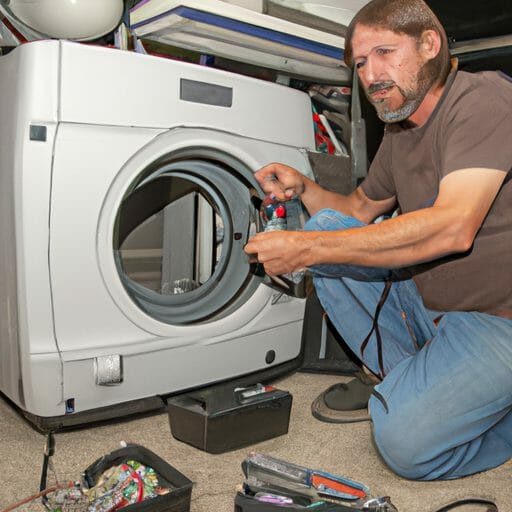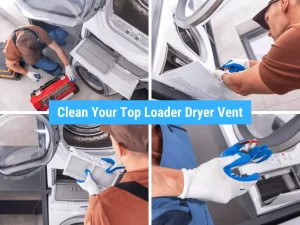DIY Repairs for RV Washers and Dryers to Save Money
Are you tired of spending a fortune on repairs for your RV washers and dryers? It’s time to take matters into your own hands and save some serious cash.
In this guide, we’ll show you how to fix common issues with your RV washer and dryer units, step-by-step. With a little bit of know-how and the right tools, you’ll be able to tackle any problem that comes your way.
So, grab your toolbox, and let’s get started on saving money while keeping your RV running smoothly.
Key Takeaways
Common Issues With RV Washers and Dryers
If you’re experiencing common issues with your RV washer and dryer, such as not spinning or not heating properly, there are several DIY repairs you can try to save money.
Troubleshooting common issues with your RV washer and dryer can be a frustrating experience, but with the right knowledge and a little bit of patience, you can often fix the problem yourself.
One of the most common issues is the washer not spinning. This can be caused by a faulty motor or a clogged drain pump. To troubleshoot this issue, you can check the motor and the drain pump for any signs of damage or blockage.
Another common problem is the dryer not heating properly. This can be due to a faulty heating element or a clogged vent. To address this issue, you can inspect the heating element and clean out any debris from the vent.
In addition to troubleshooting common issues, preventive maintenance tips can also help keep your RV washer and dryer in good working condition. Regularly cleaning the lint filter and performing routine maintenance checks can prevent future problems and extend the lifespan of your appliances.
Troubleshooting Tips for RV Washer Problems

When troubleshooting RV washer problems, it’s important to check the water supply and ensure it is properly connected. Start by examining the water hoses for any kinks or leaks. Inspect the inlet valve screen for any blockages that may be affecting the water flow.
If the water supply seems fine, the issue could lie with the washer itself. Check the control panel for any error codes or malfunctions. If you’re experiencing issues with the washer not starting or stopping mid-cycle, it could be a problem with the door latch or the motor.
Be sure to regularly clean the washer drum and perform routine maintenance to prevent buildup and prolong the lifespan of your RV washer.
Troubleshooting dryer problems in your RV may involve checking the power supply, lint filter, and ventilation system. Remember to consult your RV owner’s manual for specific troubleshooting tips and maintenance recommendations.
Step-by-Step Guide to Fixing RV Dryer Issues
To fix RV dryer issues, start by checking the power supply and making sure it is properly connected. Troubleshooting RV dryer issues can save you time and money, allowing you to enjoy your RV trips without any laundry-related hassles.
Begin by inspecting the power cord for any damage or loose connections. If everything seems fine, move on to the motor. Sometimes, a malfunctioning motor can cause the dryer to stop working. Check for any unusual noises or signs of wear and tear. If you suspect a problem, it may be necessary to replace the motor.
Remember to turn off the power before attempting any repairs. With a little patience and basic knowledge, you can successfully repair your RV dryer and keep it running smoothly for your future adventures.
Necessary Tools for DIY RV Washer and Dryer Repairs
When it comes to DIY RV washer and dryer repairs, having the right tools is essential. You need a comprehensive set of repair tools that can handle common issues such as leaks, clogs, and electrical problems.
Essential Repair Tools
You’ll need a few essential repair tools for fixing your RV washer and dryer. When it comes to repairing your appliances, having the right tools can make all the difference. Here are some essential repair tool recommendations to help you get the job done efficiently.
First, a multimeter is essential for troubleshooting electrical issues. It allows you to test for continuity, voltage, and resistance, ensuring you can accurately diagnose and fix any electrical problems.
Second, a set of screwdrivers is vital for removing panels and accessing the inner components of your washer and dryer. Make sure to have both flathead and Phillips head screwdrivers in various sizes to accommodate different screws.
Third, a pair of needle-nose pliers is useful for reaching into tight spaces and manipulating small parts. They can come in handy when removing or replacing wires or small components.
Last, a good quality socket set is essential for removing and tightening bolts and nuts. Make sure to have a variety of sizes to fit different fasteners.
Having these essential repair tools on hand will make your RV washer and dryer repairs much easier and more efficient.
Cost-Effective DIY Solutions
Using cost-effective solutions can greatly reduce the expenses of fixing common issues with your RV washer and dryer. Here are three cost-saving hacks that you can try for your DIY repair tutorials:
- Clean the lint filter regularly: A clogged lint filter can cause your dryer to work inefficiently and even lead to potential fire hazards. By cleaning it regularly, you can prevent these issues and increase the lifespan of your dryer.
- Check and tighten the hose connections: Leaky hoses can waste water and energy, resulting in higher utility bills. Take the time to inspect the hose connections and tighten them if necessary. This simple step can save you money in the long run.
- Use vinegar to descale your washing machine: Over time, mineral deposits can build up in your washing machine, affecting its performance. Using vinegar as a descaling agent can help remove these deposits, improving the efficiency of your machine and reducing the need for costly repairs.
Troubleshooting Common Issues
To troubleshoot common issues, check for any error codes displayed on the control panel of your washer or dryer. These codes can provide valuable information about the problem at hand. However, if no error codes are present, there are still several common problems with RV washers that you can troubleshoot. Refer to the table below for a quick reference guide on troubleshooting these issues.
| Common Issue | Possible Cause | Solution |
|---|---|---|
| Washer not spinning | Broken drive belt | Replace the drive belt |
| Dryer not heating | Faulty heating element | Replace the heating element |
| Excessive vibration | Unbalanced load | Distribute the load evenly |
Preventive Maintenance Tips for RV Washers and Dryers
To ensure the optimal performance and longevity of your RV washer and dryer, it is essential to implement preventive maintenance practices.
Firstly, make it a habit to clean the drum regularly to remove any accumulated lint or debris, as this can impede the machine’s efficiency.
Secondly, check the hoses for leaks on a regular basis, as even minor leaks can lead to water damage and costly repairs.
Lastly, lubricating the moving parts, such as the motor and bearings, will help reduce friction and extend the lifespan of the appliance.
Cleaning Drum Regularly
Regularly cleaning the drum of your RV washer and dryer can help prevent buildup and maintain optimal performance. Here are some best practices for cleaning the drum:
- Use a mixture of warm water and mild detergent to wipe down the interior of the drum. This will help remove any dirt, grime, or residue that may have accumulated over time.
- Pay special attention to the door seal and gasket. These areas can often trap moisture and lead to mold or mildew growth. Use a soft cloth or sponge to clean these areas thoroughly.
- Consider using a washing machine cleaner or vinegar solution to remove any lingering odors or stains. Follow the manufacturer’s instructions for the best results.
Checking Hoses for Leaks
Checking the hoses for leaks is essential in maintaining the performance and functionality of your RV washer and dryer. Regular hose maintenance is crucial to prevent any potential water damage and ensure that your appliances are operating at their best.
Start by inspecting the hoses for any signs of wear, such as cracks or bulges. It’s also important to check the connections for any looseness or leaks.
If you do find a leak, it’s crucial to address it immediately to prevent further damage. Fortunately, finding replacement parts for your RV washer and dryer is relatively easy, with many online retailers specializing in RV appliance parts.
Lubricating Moving Parts
Make sure you lubricate the moving parts of your RV washer and dryer to keep them functioning smoothly and prevent any potential damage. Here are three important reasons why lubricating these parts is crucial for the optimal performance of your appliances:
- Preventing rust: By applying lubricant to the metal components, you create a protective barrier that prevents rust from forming. Rust can lead to corrosion and weaken the parts, causing them to malfunction or break down completely.
- Reducing noise: Lubricating the moving parts helps to minimize friction between them, resulting in quieter operation. Nobody wants a noisy washer or dryer to disturb the peace and tranquility of their RV journey.
- Extending lifespan: Regularly lubricating the moving parts of your washer and dryer can significantly increase their lifespan. By reducing wear and tear, you can avoid costly repairs or replacements in the future, saving you both time and money.
Expert Advice on Extending the Lifespan of RV Washer and Dryer Units
To keep your RV washer and dryer units running smoothly for longer, you should definitely consider seeking expert advice on extending their lifespan. By doing so, you can save money and avoid costly repairs or replacements down the line.
Expert advice can provide you with valuable insights and cost-effective solutions to ensure the longevity of your RV washer and dryer units. Here are some tips from the experts to help you extend the lifespan of your appliances:
| Tips for Extending Lifespan of RV Washer and Dryer Units |
|---|
| Regularly clean lint traps and filters to prevent clogs |
| Use the recommended detergent and follow proper loading instructions |
| Inspect and clean the venting system to maintain optimal airflow |
| Schedule regular maintenance checks with a qualified technician |
Frequently Asked Questions

Can I Use Regular Laundry Detergent in My RV Washer?
Yes, you can use regular laundry detergent in your RV washer. However, it is recommended to use a low-sudsing detergent specifically made for RV washers to prevent any potential damage.
How Often Should I Clean the Lint Trap in My RV Dryer?
To maintain your RV dryer, clean the lint trap regularly. It’s important to do this to prevent buildup and ensure proper airflow. Cleaning frequency will depend on usage, but aim for at least once a month.
What Should I Do if My RV Washer Is Leaking Water?
If your RV washer is leaking water, it’s important to troubleshoot and address the issue promptly. Check for loose connections, damaged hoses, or worn-out seals. Regular maintenance can help prevent leaks and save you money in the long run.
Can I Use My RV Washer and Dryer While the RV Is in Motion?
You should not use your RV washer and dryer while the RV is in motion. It is not safe and can cause damage to the appliances and potentially harm you or others. Consider alternative laundry options for RV owners.
How Often Should I Replace the Hoses in My RV Washer and Dryer?
You should regularly inspect your RV washer hoses for signs of wear. Replace them if you notice cracks, bulges, or leaks. Proper RV washer hose maintenance is crucial for avoiding costly water damage and ensuring efficient operation.
Conclusion
In conclusion, tackling DIY repairs for your RV washers and dryers can save you a significant amount of money. By following the troubleshooting tips and step-by-step guide provided, you can easily fix common issues that may arise.
Remember to have the necessary tools on hand and practice preventive maintenance to avoid future problems. Expert advice on extending the lifespan of these units is invaluable.
So, seize the opportunity to save money and keep your RV’s laundry appliances in tip-top shape!







